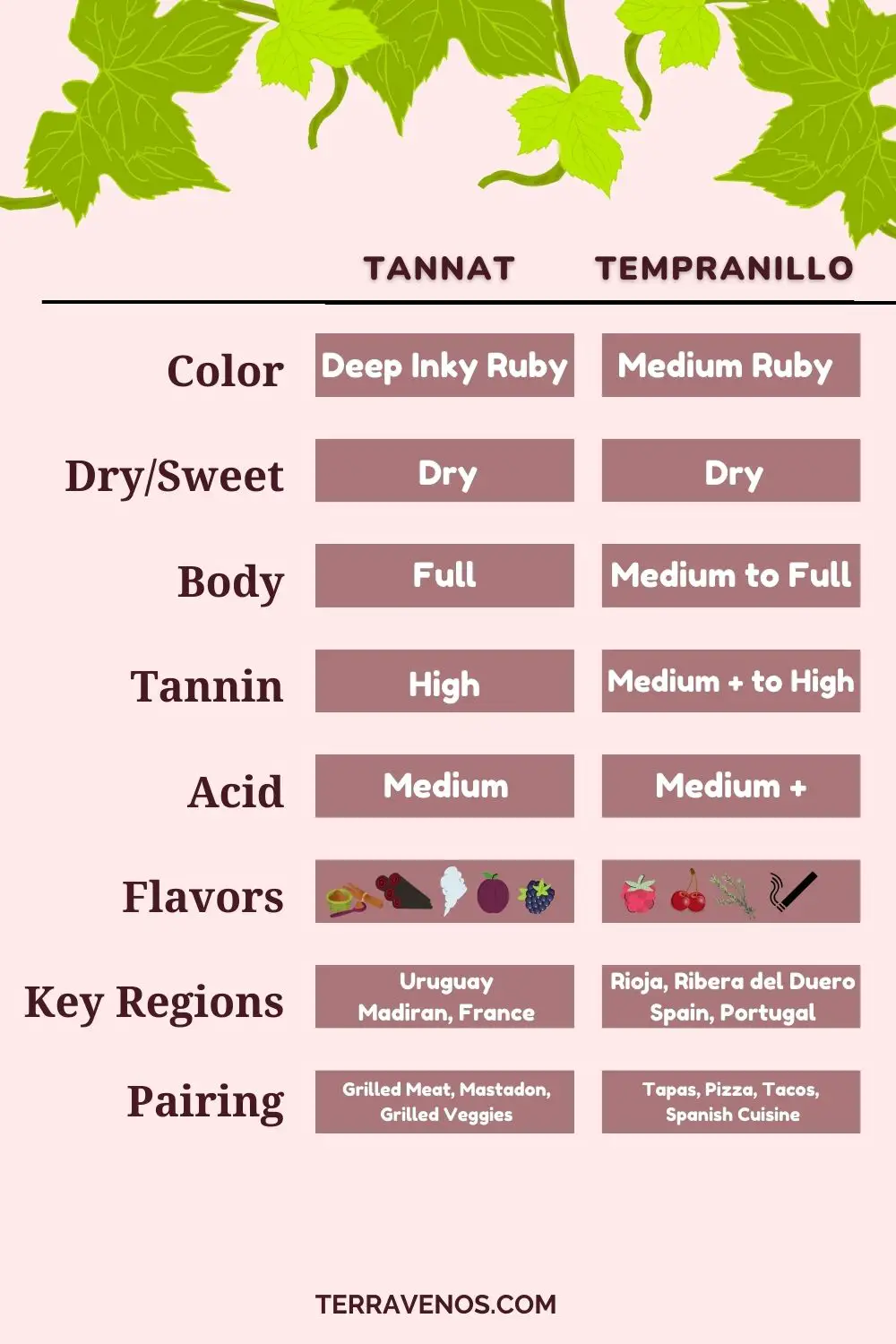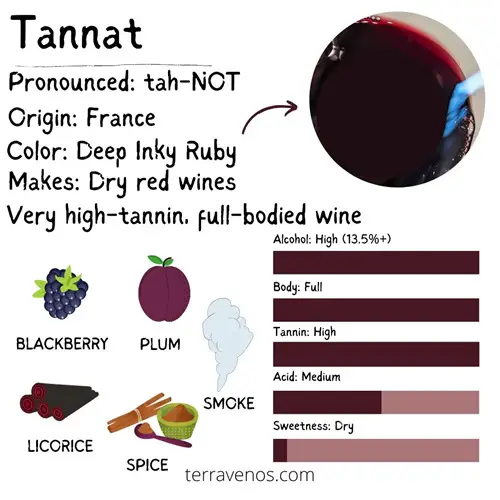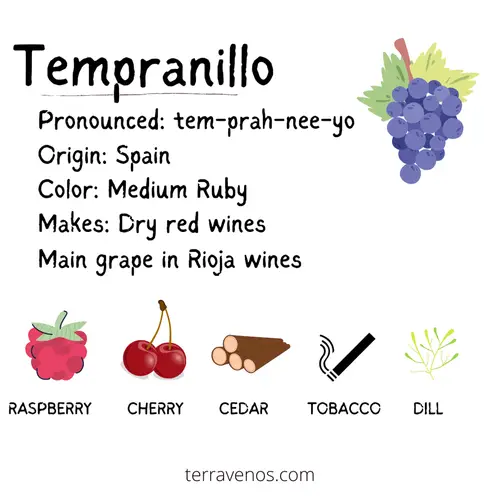
Comparing Tannat vs Tempranillo is a fun exercise. These two wines are very different.
Tannat has more tannin than Tempranillo. Tannat is black-fruited; Tempranillo has red fruit. Both are full-bodied red wines.
TL;DR: If you like Tempranillo, you may or may not like Tannat.
Tannat Basics: A Powerful Red

Tannat, from the Madiran region of southwestern France, is a powerful, tannic red wine grape that isn’t nearly as popular as some of the other big reds out there. Today, Tannat’s spiritual home is Uruguay, of all places, in a curious twist of wine fate. (Here’s a deep Tannat wines.)
You’ll find tiny pockets of Tannat grown outside of France and Uruguay from boutique producers. If you come across these wines, be sure to give them a try.
Wines from tannat are deeply colored, almost an inky-black, thanks to thick skins and small berries. Those skins leach out tannins into the wine, making for an astringent drinking experience. Tannat showcases black fruit, licorice, spice, and a smokey note.
Fun Wine Fact: The name “Tannat” derives from tannin, giving you a clue as to just how tannic this wine can be.
Tempranillo Basics: Spain’s Red Grape

Tempranillo, Spain’s #1 red wine grape, has gained recognition for its robust character. Now a global favorite, Tempranillo thrives in vineyards worldwide, from Spain’s Rioja and Ribera del Duero to New World regions.
With its deep crimson color, Tempranillo offers a palate of red berries complemented by subtle hints of coconut, herb, and cedar. This flavorful profile has made it popular among wine lovers.
Fun Wine Fact: Tempranillo gets its name from the Spanish word “temprano,” meaning early, as it usually ripens before many other grape varieties.
Helpful Tip: Here’s a complete guide to Tempranillo.

Wine Comparison: Tannat vs. Tempranillo
Here’s a quick side-by-side that covers the most common styles of Tannat and Tempranillo.
| Characteristics | Tannat | Tempranillo |
|---|---|---|
| Hue | Deep purple to inky black | Deep ruby to garnet |
| Color | Red | Red |
| Aromas | Dark fruit, chocolate, black tea, licorice, smoke | Red berries, plum, dill, tobacco, coconut |
| Tannins | Very High | Medium to High |
| Acid | Medium | Medium |
| Alcohol (%) | 13-15% | 13-15% |
| Body | Full | Full |
| Intensity | Pronounced | Moderate to pronounced |
| Blending | Blended to soften | Blended to for complexity (Rioja) |
| Key Growing Regions | Uruguay (Madiran, Tursan in France) | Spain (Rioja, Ribera del Duero), Argentina, Portugal |
| Classic Pairings | Grilled meats, hearty stews | Grilled meats, chorizo, tapas |
| Price Range | $15-$40 | $10-$50 |
Tannat Wine Profile:
- Sweetness: Tannat is a dry red wine.
- Alcohol: Tannat wines generally have a moderate to high alcohol content, ranging from around 13% to 15% ABV.
- Body: Known for its bold body, Tannat provides a powerful and complex drinking experience.
- Tannins: Tannat has higher tannin levels compared to Tempranillo.
- Acid: Tannat has medium acid levels, similar to Tempranillo
- Flavor and Aromas Intensity: Tannat will be medium plus to pronounced on the nose and palate with dark fruits, like blackberry and black plum, dark chocolate, licorice, and smoke.
Personal Note: I have Tannat wines in my cellar, but these are not wines for new wine drinkers. These are adult wines.
Tempranillo Wine Profile
- Sweetness: Tempranillo is typically produced in a dry style, offering minimal residual sugar.
- Alcohol: Tempranillo wines generally have moderate alcohol content, ranging from around 13% to 15% ABV.
- Body: Known for its medium to full body, the style of Tempranillo will depend on the growing region and winemaker.
- Tannins: Tempranillo has lower tannins than Tannat, but still in the medium to high range.
- Acid: Tempranillo has medium acid, similar to Tannat.
- Flavor and Aroma Intensity: Tempranillo has juicy red fruit, including cherry, plum, and tomato (tomato leaf); aged Tempranillo can get savory leather notes. The intensity will be in the medium (+) to high range.
Helpful Tip: Both Tannat and Tempranillo are often oaked during winemaking. Here’s what oak contributes to wine.
Are Tannat and Tempranillo Similar?
Both Tannat and Tempranillo are rich red wines with medium acid and fuller bodies. Both wines are often oaked, with mocha, coffee, and chocolate notes. Both wines have savory notes. They both have similar alcohol levels.
What Is the Difference Between Tannat and Tempranillo?
Tannat will have much stronger tannins than Tempranillo. Tannat has black fruit (like blackberry and currant); Tempranillo has red fruit (like raspberry and cherry).
Tannat vs. Tempranillo: Food Pairings and Serving Temperature

Tannat Food Pairing: Tannat’s savory and dark fruit flavors make it a versatile companion for a variety of dishes, including grilled meats and stews. This is a wine you’ll want to pair with protein and fat.
Tempranillo Food Pairing: Tempranillo, with its red fruit and savory qualities, works well with dishes that have earthy notes, think lentils, chorizo, and Spanish tapas.
Both Tannat and Tannat are best enjoyed at slightly below room temperature. Place them in a cool, dark place for a while before serving.
Which Is More Expensive, Tannat vs. Tempranillo?

Tempranillo and Tannat do have an overlapping price-point, but Tannat wines won’t be as widely available depending on where you live in the world. Tannat just doesn’t share Tempranillo’s fame as a food wine.
Tannat Cost
Entry-level Tannat wines are typically affordable, ranging from $15 to $20 per bottle.
If you are looking for premium Tannat, there are higher-priced Tannat wines available. These bottles, priced around $25 to $40 or higher, offer a more complex and nuanced drinking experience.
Tempranillo Cost
Similar to Tannat, entry-level Tempranillo wines also fall within accessible price ranges, usually ranging from $10 to $20 per bottle. These wines are known for their easy-drinking and approachable style.
Premium Tempranillo will have more intense fruit flavors and likely aging. You’ll immediately notice just how pronounced they can be. Premium Tempranillo wines sourced from renowned regions can have wine prices of $30-$50+.
Which Is Better Tannat or Tempranillo?
If you enjoy bold, robust red wine with dark fruit, smoke, and tannin, Tannat will be better for you. If you prefer a medium to full-bodied wine with bright fruit and a touch of savory earth, then Tempranillo is better.
Final Thoughts – Tannat or Tempranillo?
Both Tannat and Tempranillo are very different wines. One is a tannic monster, the other not so much.
I’m a big fan of side-by-side tastings to tease out the different wine characteristics. A great way to get started with these two wines is to do a side-by-side comparison.
Grab 2 bottles of similarly priced Tannat and Tempranillo. Invite over a few friends and enjoy an evening of swirling and sipping.
Helpful Tip: These are both food wines. Make sure you have something to eat along with them.
Thirsty for More?
I’m a big believer in doing side-by-side tastings to boost your wine knowledge. Here’s how to host your own wine tasting for beginners.
Check out this post on Cabernet Sauvignon vs Merlot, another popular red wine, along with Cabernet Sauvignon vs Malbec, and Shiraz vs Merlot.
You should be able to find delicious wines at every price point. Check out this post on how to find great wines under $50.




